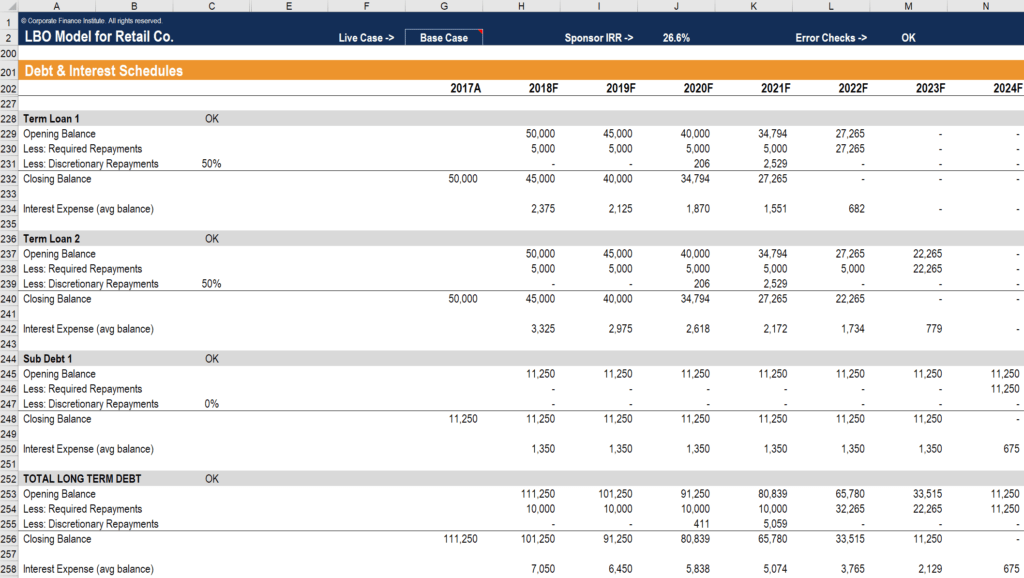Debt Schedule
A repayment schedule of debt in Excel
What is a Debt Schedule?
A debt schedule lays out all of the debt a business has in a schedule based on its maturity. It is typically used by businesses to construct a cash flow analysis. As shown in the graphic below, interest expense in the debt schedule flows into the income statement, the closing debt balance flows onto the balance sheet, and principal repayments flow through the cash flow statement (financing activities).
The debt schedule is one of the supporting schedules that ties together the three financial statements.
The interest expense calculated above (row 258) flows onto the income statement as interest expense. The closing balance (row 256) flows onto the balance sheet as the total debt value, under liabilities. In this example, interest expense is based on a fixed interest rate multiplied by the average debt balance for the period (opening plus closing, divided by two). The example above is from CFI’s LBO Financial Modeling Course.
Components of a Debt Schedule in a Financial Model
When building a financial model, an analyst will almost always have to build a supporting schedule in Excel that outlines debt and interest.
Components of this schedule include:
- Opening balance (beginning of the period)
- Repayments (decreases)
- Draws (increases)
- Interest expense
- Closing balance (end of the period)
The above items allow the debt to be tracked until maturity. The closing balance from the schedule flows back to the balance sheet, and the interest expense flows to the income statement.
Types of Debt Listed in a Debt Schedule
To construct a debt schedule, analysts need to list all debt currently outstanding by the business. The types of debt include:
- Loans
- Leases
- Bonds
- Debentures
Factors to Consider in the Construction of a Debt Schedule
Before committing to borrow money, a company needs to carefully consider its ability to repay debt and the real cost of the debt. Here is a list of the factors a company needs to consider:
- Debt maturity – Most debt is amortized and paid monthly. The longer the maturity of the debt, the lower the amount due monthly, yet the higher the total sum of the debt and interest accrued.
- Interest rate – The lower the interest rate, the better, but not always. A low interest rate for a long-term debt usually results in higher total interest due than short-term debt with a high interest rate.
- Floating or fixed interest – A floating interest rate will change the overall debt service payment amount each year, while a fixed interest rate provides reliability in the calculation. Depending on the future assumptions, a floating interest rate is the better choice in a low or declining interest rate environment.
- Ability to generate gain – There is no reason to take on new debt if the debtor cannot use the funds to generate a steady stream of income to pay the debt off. Failure to pay a debt might result in a drop in their credit rating or even forced liquidation.
Why is a Debt Schedule Important?
The ability to estimate the total amount a company needs to pay once a debt matures is the main reason a debt schedule is made. Another reason for using a debt schedule includes the company’s ability to monitor the maturity of the debt and make decisions based on it, such as the possibility of refinancing the debt through a different institution/ source when the interest rate declines.
The debt schedule report can be used as an instrument to negotiate a new line of credit for the company. Lenders will use the report and consider the risk/reward before granting new credit.
More Resources
CFI is the official provider of the global Financial Modeling & Valuation Analyst (FMVA)™ certification program, designed to help anyone become a world-class financial analyst. To keep advancing your career, the additional CFI resources below will be useful:
